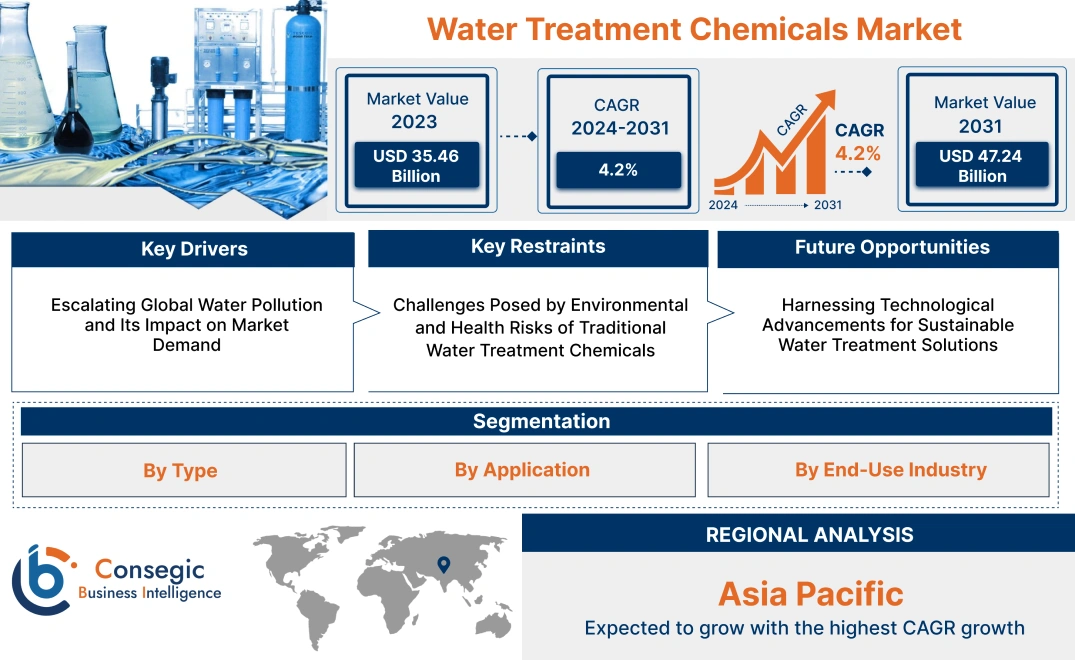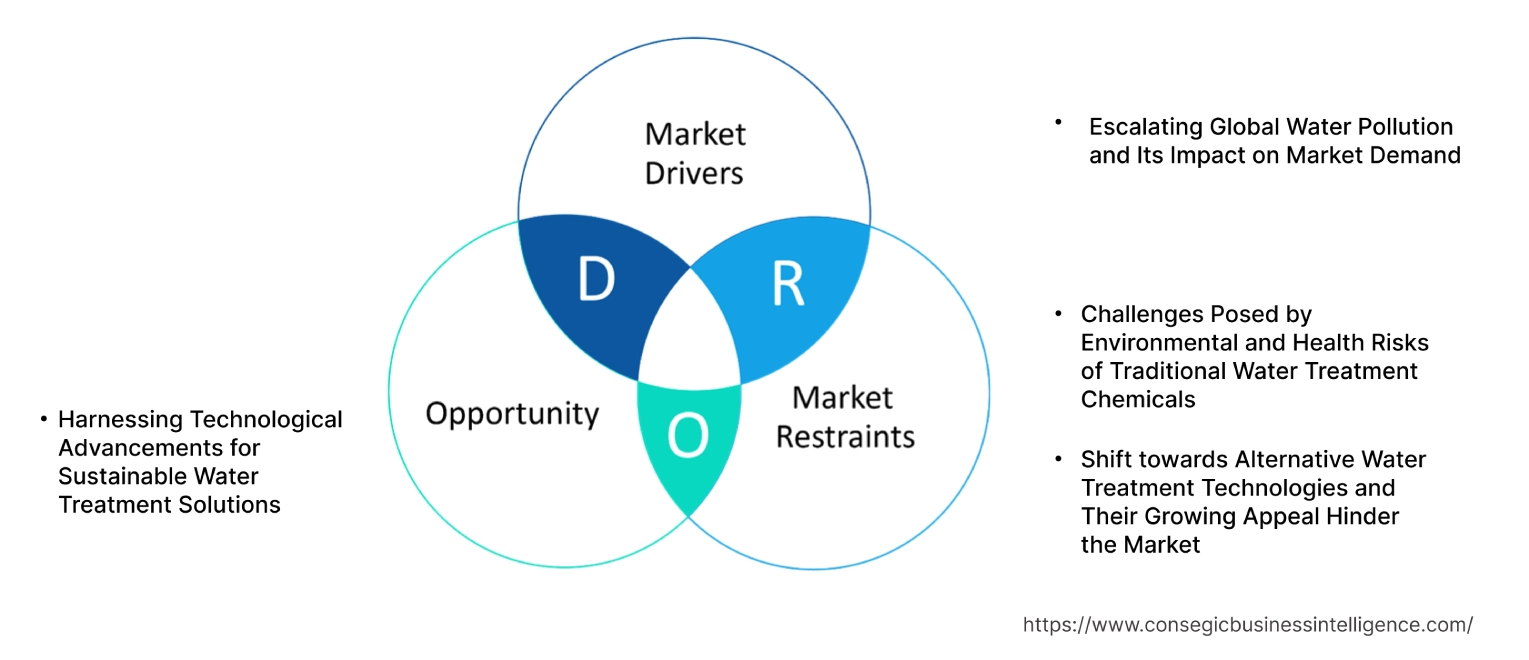- Summary
- Table Of Content
- Methodology
Water Treatment Chemicals Market Size:
Water Treatment Chemicals Market size is growing with a CAGR of 4.2% during the forecast period (2024-2031), and the market is projected to be valued at USD 47.24 Billion by 2031 from USD 35.46 Billion in 2023.
Water Treatment Chemicals Market Scope & Overview:
Water treatment chemicals refer to the specialized chemicals, including coagulants, flocculants, disinfectants, and corrosion inhibitors, used to remove contaminants in the water treatment processes, reducing harmful substances and preventing corrosion. The advantages include enhanced water quality, reduction in health risks, and reusing the water for various purposes, utilizing corrosion inhibitors. They are used for treating drinking water, wastewater management, and industrial and cooling water treatments. The primary end-user industries include municipalities, power generation, manufacturing, and oil and gas industries.
Water Treatment Chemicals Market Insights:
Key Drivers:
Escalating Global Water Pollution and Its Impact on Market Demand
Due to the rapid shift towards industrialization, urbanization, and increasing population, the concern for water pollution is rising globally. Advanced water treatment chemicals like coagulants, flocculants, disinfectants, and corrosion inhibitors, are required to purify the hazardous chemicals in the water bodies such as heavy metals, and organic pollutants, ensuring safe and clean drinking water. The usage of such advanced chemicals inhibits the increase in waterborne diseases and neutralizes hazardous substances.
- In December 2022, due to the contamination of water in almost 29 countries, there was a cholera outbreak globally, emphasizing the need for water treatment chemicals all over the world.
Therefore, the analysis portrays that the rapid urbanization and the resulting water pollution, are driving the water treatment chemicals market growth.
Key Restraints :
Challenges Posed by Environmental and Health Risks of Traditional Water Treatment Chemicals
The government laws and policies are majorly influenced by the environmental and health scenario regarding water bodies, emphasizing the requirement for water treatment chemicals. Some of these chemicals release harmful by-products such as Trihalomethanes (THMs) and Haloacetic Acids (HAAs), from chlorine and its derivatives.
Additionally, the release of these harmful by-products affects aquatic life and can cause diseases including cancer in humans. Thus, analysis of market trends shows that the harmful effects caused by these chemicals cause a restraint in the water treatment chemicals market demand.
Shift towards Alternative Water Treatment Technologies and Their Growing Appeal Hinder the Market
Water treatment methods such as membrane filtration, UV radiation, and advanced oxidation, act as an alternative to the chemicals required for water treatment. They can treat various contaminants, consume fewer chemicals, and have less environmental impact. Moreover, technologies based on a physical barrier such as membrane filtration have been gaining traction in recent years, due to their effectiveness and low chemical usage.
- In November 2021, DuPont launched its TapTec™ LC HF-4040 RO membrane filter, focusing on infrastructures such as offices and hotel buildings.
Therefore, the analysis depicts that the growing shift towards advanced water treatment technologies like membrane filtration and UV radiation is causing a restraint in the water treatment chemicals market growth.
Future Opportunities :
Harnessing Technological Advancements for Sustainable Water Treatment Solutions
Advancements, such as formulations including high-efficiency nanoemulsions and hybrid treatment systems, and enhanced eco-friendly chemicals such as bio-based coagulants and flocculants, led to the adoption of these chemicals and lead to newer innovations in the sector. Moreover, the adoption of these environmentally friendly chemicals would reduce health and environmental hazards, and increase the treatment process efficiency of different water bodies.
- For instance, PHASETREAT™ WET was launched by Clariant Oil Services in 2023. It is a chemical that uses nanoemulsion technology for water treatment.
Therefore, the market trends analysis shows that technological advancements in the treatment chemicals for water will accelerate the water treatment chemicals market opportunities significantly.
Water Treatment Chemicals Market Segmental Analysis :
By Type:
Based on type, the water treatment chemicals market is segmented into coagulants & flocculants, disinfectants, corrosion & scale inhibitors, pH adjusters, defoamers, and others.
Trends in the Type:
- Green chemistry is continuously evolving in the corrosion & scale inhibitors sector, as they protect against corrosion.
- Smart chemical technology is rapidly growing in the pH adjusters and defoamers sectors, ensuring minimum wastage of chemicals with the integration of sensors and automated systems.
The coagulants & flocculants sector accounted for the largest revenue share of 38.77% in 2023.
- In the process of coagulation, the negative charges from suspended particles are neutralized by adding coagulants, leading them to clump together to form micro-flocs.
- In the process of flocculation, the coagulated particles form larger units called the macro-flocs, with the addition of water-soluble polymers-flocculants, these particles are much easier to remove.
- Water treatment processes use these techniques as they facilitate the removal of particles, as the chemicals help the suspended particles to aggregate.
- This is also utilized in the municipal and industrial sectors due to the strict water quality regulations.
- In November 2023, a multi-million euro investment was made by Kemira, to expand the ferric sulfate coagulant production in Google, UK.
- Therefore, the growing need for better quality drives the water treatment chemicals market demand.
The disinfectants sector is anticipated to register the fastest CAGR during the forecast period.
- A class of chemical agents used to inhibit the growth of pathogens in water are known as disinfectants. They are used to make consumption of water much safer, along with other industrial processes.
- The increasing awareness of waterborne diseases is facilitating the usage of disinfectants and finding methods to deal with the growing microbial resistance.
- New disinfectants such as nanotechnology-integrated disinfectants are continuously under development, as they provide better microbial control.
- Hence, the continuous growth of microbes and the diseases led by them are driving the water treatment chemicals market trends.
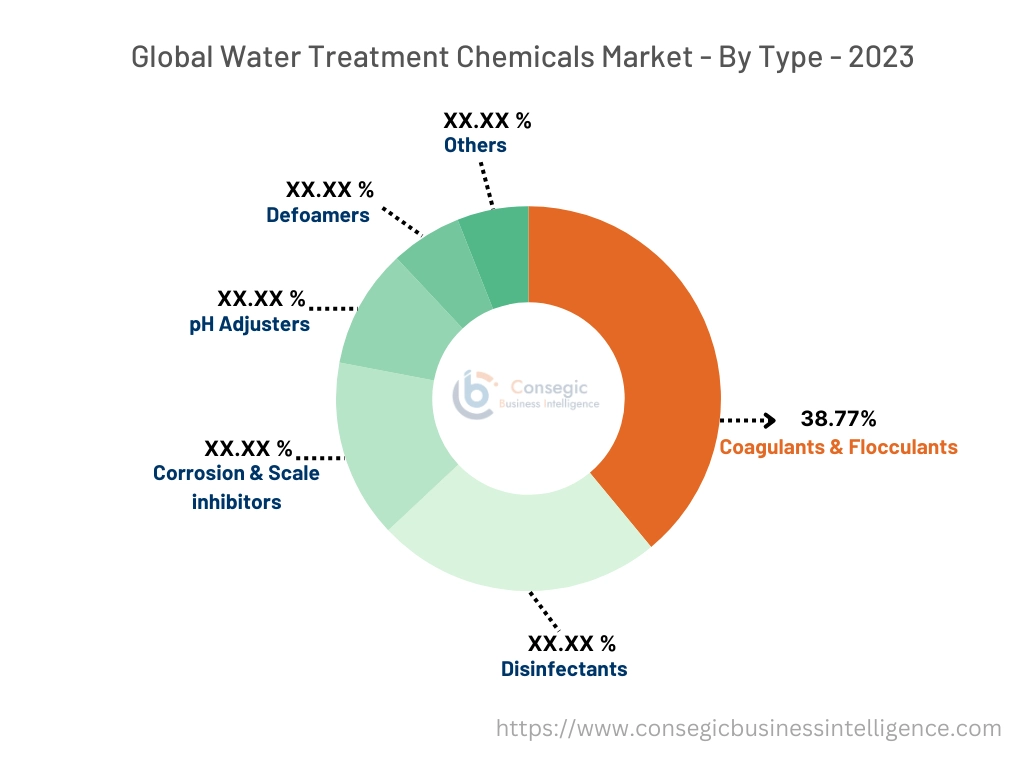
By Application:
Based on Application, the water treatment chemicals market is segmented by application into municipal water treatment, industrial water treatment, wastewater treatment, cooling water treatment, and others.
Trends in the Application:
- Customized water treatment solutions are developed based on the specific requirements of industries like electronics and pharmaceuticals.
- Hybrid chemical treatments combining various functions like corrosion inhibition, microbial growth control, and scale prevention are being adopted into the cooling water treatment process.
The municipal water treatment sector accounted for the largest revenue share of the total water treatment chemicals market share in 2023.
- Safe drinking water is extremely essential for everyone, hence the water treatments by municipal water systems are very important.
- In developing countries, strict government initiatives are taken to improve water infrastructure and give everyone access to cleaner water.
- Government initiatives are implemented for improvement in water infrastructure, particularly in those emerging economies where access to clean water remains an issue.
- Advanced monitoring systems are being adopted to ensure that processes by the municipal water treatment systems are reliable and efficient. Water treatment practices that are sustainable are also continuously being adopted.
- For instance, becoming the first U.S. city to this treatment in water supply. Chlorine prevents the spreading of germs such as Salmonella and Campylobacter.
- Therefore, the growing awareness towards safe drinking water and government initiatives are driving the water treatment chemicals market trends.
The wastewater treatment sector is anticipated to register the fastest CAGR during the forecast period.
- Due to the strict waste discharge regulations, there is a need for chemical solutions for wastewater treatment.
- Advancements in advanced oxidation processes (AOPs), membrane bioreactors (MBRs), and electrochemical treatments have also benefited this sector significantly, aligning with the sustainability goals and reducing the impact of wastewater.
- In 2023, the world's first biomass-balanced flocculants for wastewater treatment called "Superfloc® BioMB" was launched by Kemira. They contain 50% raw material and reduce carbon emissions significantly.
- Therefore, the stringent regulations and sustainability goals place this segment as the fastest-growing application in the market.
By End-Use Industry:
Based on the end-use industry, the market is segmented into power generation, oil & gas, chemicals & petrochemicals, food & beverage, pharmaceuticals, and others.
Trends in the End-Use Industry:
- To improve the Enhanced Oil Recovery (EOR) process, and reduce the ecological footprint of extraction, advanced water treatment chemicals are continuously being introduced in the oil & gas sector.
- To achieve the demand for environmental concerns and meet the stringent environmental regulations green water treatment chemicals are continuously adopted.
The power generation sector accounted for the largest revenue of the overall water treatment chemicals market share in 2023.
- Power generation plants utilize treated water for cooling and steam generation, necessitating the usage of water treatment chemicals.
- The usage of specialized water treatment solutions is influenced by the growing integration of clean energy sources like natural gases and renewable sources.
- These ensure the reliability and efficiency of power generation processes, further reducing the burdens.
- For instance, Veolia finds the solution to ultra-pure water for steam generation to prevent scale and corrosion, using tools such as reverse osmosis, mobile demineralization units, and ultrafiltration.
- Therefore, the growing demand for sustainable solutions is driving the power generation sector in the water treatment chemicals market.
The pharmaceuticals sector is anticipated to register the fastest CAGR during the forecast period.
- Qualitative water treatment is necessary to ensure pure water for formulation and manufacturing in the pharmaceutical sector.
- Sectors including biologics and other advanced therapies accelerate the need for better water quality.
- To reduce the risk of contamination advanced water treatments are extremely important to ensure better water quality during the pharmaceutical processes.
- The sector is further being driven by the use of advanced chemical treatment capable of restoring the quality of water periodically, thereby decreasing the potential risk of pharmaceutical production contamination.
- For instance, The water purity is handled effectively with the EVALED water treatment systems, using the APIs, reducing the overall contamination risks and enabling reusing.
Regional Analysis:
The regions covered are North America, Europe, Asia Pacific, the Middle East and Africa, and Latin America.
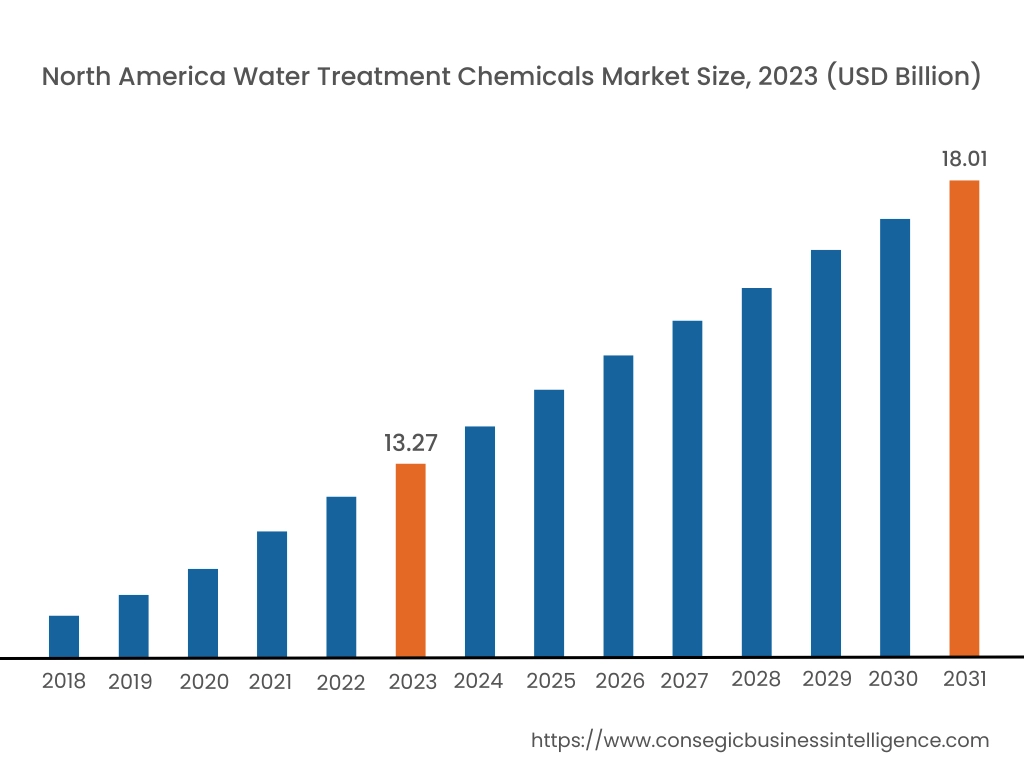
In 2023, North America accounted for the highest market share at 37.43% and was valued at USD 13.27 Billion, and is expected to reach USD 18.01 Billion in 2031. In North America, the U.S. accounted for the highest market share of 72.32% during the base year of 2023. As per the water treatment chemicals market analysis, stringent environmental laws like the Environmental Protection Agency (EPA), drive the market in the region. These policies require industrial and municipal wastewater to be treated before discharge. Industries such as power generation, food and beverages, and pharmaceuticals continuously demand clean and safe water, contributing to the water treatment chemicals market expansion.
- To combat Legionella bacteria, new chemicals and disinfection services for water treatment were launched by a U.S. chemical product and services company, ChemREADY , in 2022.
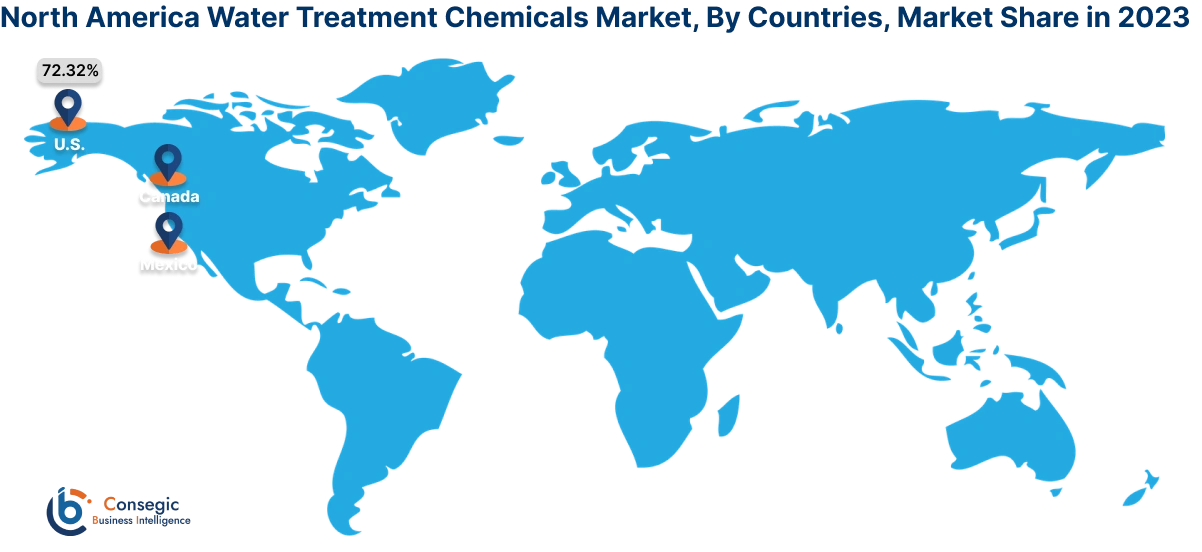
Asia Pacific is expected to witness the fastest CAGR over the forecast period of 5.9% during 2024-2031. Rapid industrialization and urbanization, are causing the development in this region, especially in countries like China and India. This increases the need for water treatment solutions due to the growing need for clean water. Environmental awareness and preventative measures for waterborne diseases further accelerate the market.
- A long-term investment plan was introduced by DOMO Chemicals to expand the production capacity in China for TECHNYL® polyamide in 2022. This is to meet the growing demand for sustainable water treatment methods.
The strict environmental regulations, leading to the advancement in water treatment technologies are driving the market in the region of Europe. In the Middle East and Africa, desalination and wastewater treatment, accelerate the water treatment chemicals market expansion. The regional trends analysis shows that the primary factor for the market growth in Latin America is the growing investments in waste treatment infrastructure.
Top Key Players & Market Share Insights:
The water treatment chemicals market is highly competitive with major players providing products and services to the national and international markets. Key players are adopting several strategies in research and development (R&D), product innovation, and end-user launches to hold a strong position in the global water treatment chemicals market. Key players in the water treatment chemicals industry include –
Recent Industry Developments :
Product Launches:
- In April 2024, CURE Chemicals was launched by Gradient, aiming to align with the goals of achieving sustainability and efficiency. This new line includes a range of products including corrosion and scale inhibitors, process chemicals, biocides, antiscalants & cleaners, and coagulants & flocculants.
Divestments:
- In February 2024, Kemira announced the finalization of the sale of its Oil & Gas portfolio, acquired by Sterling Specialty Chemicals LLC. This will allow Kemira to entirely focus on the expansion of its renewable technologies, wastewater solutions, and digital services.
Merges and Acquisitions:
- In October 2023, Cedarchem was acquired by Solenis, to provide enhanced chemical and wastewater treatment products and services to its customers.
Partnerships & Collaborations:
- In April 2023, CITCO and Trivest partners, aiming the expansion of its wastewater treatment facilities throughout the U.S. Trivest will enable the growth of the water distribution and wastewater treatment solutions to grow exponentially, with its strategic and financial plans.
Water Treatment Chemicals Market Report Insights :
| Report Attributes | Report Details |
| Study Timeline | 2018-2031 |
| Market Size in 2031 | USD 47.24 Billion |
| CAGR (2024-2031) | 4.2% |
| By Type |
|
| By Application |
|
| By End-use Industry |
|
| By Region |
|
| Key Players |
|
| North America | U.S. Canada Mexico |
| Europe | U.K. Germany France Spain Italy Russia Benelux Rest of Europe |
| APAC | China South Korea Japan India Australia ASEAN Rest of Asia-Pacific |
| Middle East and Africa | GCC Turkey South Africa Rest of MEA |
| LATAM | Brazil Argentina Chile Rest of LATAM |
| Report Coverage |
|
Key Questions Answered in the Report
How big is the water treatment chemicals market? +
Water Treatment Chemicals Market size is growing with a CAGR of 4.2% during the forecast period (2024-2031), and the market is projected to be valued at USD 47.24 Billion by 2031 from USD 35.46 Billion in 2023.
What specific segmentation details are covered in the water treatment chemicals market report? +
The water treatment chemicals report includes specific segmentation details for type, application, end-use industry, and region.
Which is the fastest segment anticipated to impact the market growth? +
In the type segment, disinfectants are the fastest-growing segment during the forecast period due to increasing water safety concerns globally.
Who are the major players in the water treatment chemicals market? +
The key participants in the water treatment chemicals market are BASF (Germany), Ecolab (U.S), Solenis (U.S), Kemira (Finland), Akzo Nobel N.V. (Netherlands), Dow (U.S), SUEZ Water Technologies & Solutions (Sri Lanka), Kurita Water Industries Ltd. (Japan), Lonza (Switzerland), SNF (France).
